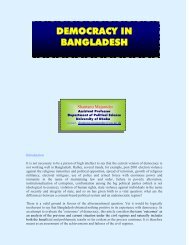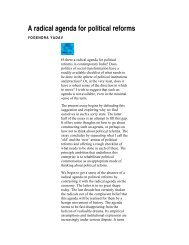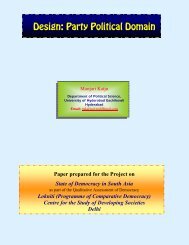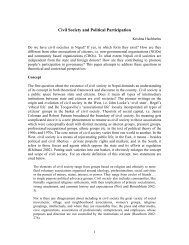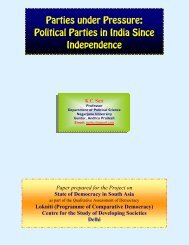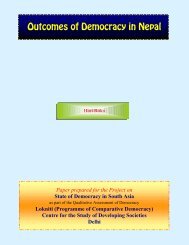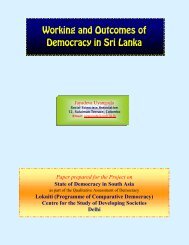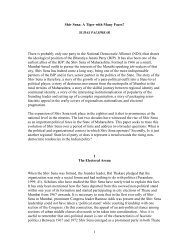D.L.Sheth ,Caste in the Mirror of Race, Seminar ... - Democracy Asia
D.L.Sheth ,Caste in the Mirror of Race, Seminar ... - Democracy Asia
D.L.Sheth ,Caste in the Mirror of Race, Seminar ... - Democracy Asia
Create successful ePaper yourself
Turn your PDF publications into a flip-book with our unique Google optimized e-Paper software.
<strong>Caste</strong> <strong>in</strong> <strong>the</strong> mirror <strong>of</strong> race<br />
D.L. SHETH<br />
THE demand to equate caste oppression<br />
with racial discrim<strong>in</strong>ation has triggered a<br />
new debate <strong>in</strong> <strong>the</strong> dalit movement. A section<br />
<strong>of</strong> dalit activists have <strong>in</strong>itiated a global<br />
campaign for <strong>in</strong>corporat<strong>in</strong>g <strong>the</strong> issue <strong>of</strong><br />
untouchability <strong>in</strong> India with<strong>in</strong> <strong>the</strong> wider<br />
western discourse on racism. This campaign<br />
ga<strong>in</strong>ed visibility at <strong>the</strong> Geneva conference<br />
attended by several dalit <strong>in</strong>tellectuals and<br />
activists as well as some government<br />
representatives and was fur<strong>the</strong>r streng<strong>the</strong>ned<br />
at <strong>the</strong> World Congress aga<strong>in</strong>st Racism and<br />
Xenophobia (WCAR) held recently <strong>in</strong><br />
Durban. Among o<strong>the</strong>r objectives, it aims at<br />
mak<strong>in</strong>g <strong>the</strong> United Nations accept that caste<br />
oppression be <strong>of</strong>ficially treated as a form <strong>of</strong><br />
racial discrim<strong>in</strong>ation and, as such, an<br />
<strong>in</strong>ternational campaign be launched aga<strong>in</strong>st<br />
it under <strong>the</strong> aegis <strong>of</strong> <strong>the</strong> world organization.<br />
Notably, political parties like <strong>the</strong> BSP and<br />
<strong>the</strong> Republican Party who claim to represent<br />
dalit <strong>in</strong>terests did not jo<strong>in</strong> <strong>the</strong> debate and <strong>the</strong><br />
campaign rema<strong>in</strong>ed more or less conf<strong>in</strong>ed to<br />
<strong>the</strong> NGOs. Particularly active were <strong>the</strong><br />
organizations attached to <strong>the</strong> World Council<br />
<strong>of</strong> Churches. Indeed, some <strong>of</strong> <strong>the</strong><br />
organizations lead<strong>in</strong>g this movement even<br />
hoped to assume political leadership <strong>of</strong><br />
dalits, replac<strong>in</strong>g those whose primary<br />
political preoccupation, <strong>in</strong> <strong>the</strong>ir view, has<br />
only been with electoral calculus. This new,<br />
aggressive politics <strong>of</strong> NGOs has contributed<br />
to a situation where anyone even <strong>in</strong> slight<br />
disagreement with <strong>the</strong>se organizations is<br />
labelled a supporter <strong>of</strong> untouchability and<br />
brahmanism.
As for <strong>the</strong> attitude <strong>of</strong> <strong>the</strong> government, it was,<br />
as ever, a knee-jerk reaction. Whe<strong>the</strong>r it is<br />
an issue <strong>of</strong> violation <strong>of</strong> human rights by its<br />
own <strong>in</strong>stitutional agencies, <strong>of</strong> child labour or<br />
<strong>the</strong> demand for declar<strong>in</strong>g tribes as<br />
<strong>in</strong>digenous peoples, we witness a similar<br />
conditioned response from <strong>the</strong> government.<br />
If those oppos<strong>in</strong>g a particular policy do not<br />
achieve a degree <strong>of</strong> coherence about <strong>the</strong><br />
terms <strong>in</strong> which to oppose <strong>the</strong> policy, it gives<br />
<strong>the</strong> government an additional excuse to<br />
ignore <strong>the</strong> opposition.<br />
Yet, I believe, <strong>the</strong> political implications <strong>of</strong><br />
view<strong>in</strong>g <strong>the</strong> problem <strong>of</strong> caste from <strong>the</strong><br />
perspective <strong>of</strong> race could be quite serious<br />
and should, <strong>the</strong>refore, be exam<strong>in</strong>ed as<br />
dispassionately as possible. I would,<br />
however, like to make it clear at <strong>the</strong> very<br />
outset that I see noth<strong>in</strong>g wrong <strong>in</strong> <strong>the</strong><br />
<strong>in</strong>ternationalization <strong>of</strong> caste. First, caste<br />
discrim<strong>in</strong>ation is by no means conf<strong>in</strong>ed to<br />
Indian society alone. It is found <strong>in</strong> several<br />
countries <strong>of</strong> South <strong>Asia</strong> and East <strong>Asia</strong>, even<br />
though its nature and extent may vary. Even<br />
untouchability is not an exclusively Indian<br />
practice. For example, because <strong>of</strong> <strong>the</strong>ir long<br />
association with lea<strong>the</strong>rwork <strong>in</strong> <strong>the</strong> past, <strong>the</strong><br />
Buraku <strong>of</strong> Japan suffer a predicament<br />
comparable to that <strong>of</strong> <strong>the</strong> chamars <strong>of</strong> India.<br />
The case <strong>of</strong> <strong>the</strong> Peekchongas <strong>of</strong> Korea and<br />
Ragyappas <strong>of</strong> Tibet may also be cited <strong>in</strong> this<br />
context.<br />
Second, if untouchability is a crime aga<strong>in</strong>st<br />
humanity, which it <strong>in</strong>deed is, how on earth<br />
can we assume that all <strong>of</strong> humanity is
exhausted <strong>in</strong> <strong>the</strong> Indian nation state? The<br />
question <strong>of</strong> untouchability should not be<br />
seen as one <strong>of</strong> nationalism; it is about <strong>the</strong><br />
right to be human. As such <strong>the</strong> question<br />
must be raised <strong>in</strong> all available and<br />
appropriate fora so that a powerful politics<br />
aga<strong>in</strong>st its ideology and practice can be built<br />
up, both nationally and globally. It is<br />
necessary to construct a universal moral<br />
discourse aga<strong>in</strong>st all types <strong>of</strong> social and<br />
cultural practices lead<strong>in</strong>g to different forms<br />
<strong>of</strong> sub-humanization <strong>of</strong> <strong>the</strong> excluded<br />
‘o<strong>the</strong>rs’. This, however, should not compel<br />
us to mix metaphors/categories <strong>in</strong> a manner<br />
that might prove counter productive <strong>in</strong><br />
devis<strong>in</strong>g a politics to counter <strong>the</strong> process <strong>of</strong><br />
sub-humanization <strong>of</strong> specific population<br />
groups <strong>in</strong> society.<br />
To enter <strong>in</strong>to <strong>the</strong> debate about whe<strong>the</strong>r or<br />
not to equate caste with race would be futile.<br />
For, it is easy to show <strong>the</strong>oretically,<br />
sociologically and scientifically that <strong>the</strong><br />
<strong>Asia</strong>n phenomenon <strong>of</strong> caste is <strong>in</strong> some basic<br />
respects dissimilar to <strong>the</strong> western<br />
phenomenon <strong>of</strong> race. <strong>Race</strong> has a biological<br />
connotation whereas caste is a socio-cultural<br />
construct. It is obvious that like any o<strong>the</strong>r<br />
caste conglomeration, <strong>the</strong> dalits <strong>of</strong> different<br />
regions <strong>of</strong> India cannot be seen as <strong>of</strong> one<br />
race.<br />
To be sure, both caste and race are<br />
hereditary. Unlike race, however, a caste<br />
formation is not determ<strong>in</strong>ed by biological<br />
characteristics such as <strong>the</strong> colour <strong>of</strong> one’s<br />
sk<strong>in</strong>. It is a function <strong>of</strong> a complex sociohistorical<br />
structure with<strong>in</strong> which a social<br />
group is assigned a ritual status specify<strong>in</strong>g a<br />
degree <strong>of</strong> purity or pollution attached to it,<br />
an occupation, and a specific range, with<strong>in</strong><br />
which its members can forge matrimonial<br />
alliances. Racism on <strong>the</strong> o<strong>the</strong>r hand is a<br />
form <strong>of</strong> social and political discrim<strong>in</strong>ation<br />
based on biologically manifest <strong>in</strong>ter-group<br />
differences. In any case, <strong>the</strong> European
claims regard<strong>in</strong>g <strong>the</strong> <strong>in</strong>herent superiority <strong>of</strong><br />
one social group over <strong>the</strong> o<strong>the</strong>r have been<br />
thoroughly discredited.<br />
While <strong>the</strong> fact that caste is different from<br />
race cannot be disputed, several aspects <strong>of</strong><br />
<strong>in</strong>justice on account <strong>of</strong> racial discrim<strong>in</strong>ation<br />
<strong>in</strong> Europe, America and Africa appear<br />
similar to those perpetrated <strong>in</strong> <strong>the</strong> name <strong>of</strong><br />
caste <strong>in</strong> India. The earlier generation <strong>of</strong> dalit<br />
leaders even started a Dalit Pan<strong>the</strong>r<br />
movement, draw<strong>in</strong>g <strong>in</strong>spiration from <strong>the</strong><br />
Black Pan<strong>the</strong>r movement <strong>in</strong> <strong>the</strong> US. A<br />
number <strong>of</strong> established dalit littŽrateurs have<br />
fruitfully used <strong>the</strong> idiom and imagery <strong>of</strong> <strong>the</strong><br />
anti-apar<strong>the</strong>id movement to analyze and<br />
articulate dalit awareness and aspirations.<br />
II<br />
The fact <strong>of</strong> <strong>the</strong> matter is that <strong>the</strong> issue <strong>of</strong><br />
caste vs. race is primarily political ra<strong>the</strong>r<br />
than academic, and must be understood as<br />
such. While it is true that no national society<br />
can objectively be divided <strong>in</strong>to racial<br />
groups, for <strong>the</strong> idea <strong>of</strong> racial purity has been<br />
proved to be nonexistent, discrim<strong>in</strong>ation on<br />
<strong>the</strong> basis <strong>of</strong> a perceived notion <strong>of</strong> race is a<br />
reality. It is, <strong>the</strong>refore, irrelevant whe<strong>the</strong>r <strong>the</strong><br />
notion <strong>of</strong> race is scientific or not. It is a<br />
socially, culturally and politically operative<br />
construct on <strong>the</strong> basis <strong>of</strong> which a section <strong>of</strong><br />
<strong>the</strong> population is seen as <strong>the</strong> lesser and<br />
<strong>in</strong>ferior ‘o<strong>the</strong>r’. A racial division <strong>of</strong> ‘us’ and<br />
‘<strong>the</strong>m’ has thus become a prevalent<br />
classificatory scheme, even when <strong>the</strong> idea <strong>of</strong><br />
race is scientifically rejected.<br />
This scheme is <strong>in</strong>formed by a culturally<br />
constructed belief that certa<strong>in</strong> communities<br />
are lack<strong>in</strong>g <strong>in</strong> specific biophysiological<br />
virtues because <strong>of</strong> <strong>the</strong> colour <strong>of</strong> <strong>the</strong>ir sk<strong>in</strong>, a<br />
particular shape <strong>of</strong> nose or a specific type <strong>of</strong><br />
hair texture. This biocultural belief,
however, is sought to be presented as a<br />
‘scientific truth’. Even after <strong>the</strong> legitimacy<br />
<strong>of</strong> such beliefs is conclusively repudiated,<br />
<strong>the</strong> structures <strong>of</strong> associated ideas and<br />
prejudices cont<strong>in</strong>ue to affect <strong>in</strong>tercommunity<br />
relations. The racial discourse is<br />
thus designed to marg<strong>in</strong>alize certa<strong>in</strong> groups<br />
and deprive <strong>the</strong>m <strong>of</strong> normal <strong>in</strong>dividual and<br />
group rights. That is why, despite its<br />
scientific <strong>in</strong>validation, racism not only<br />
survives but cont<strong>in</strong>ues to grow. It f<strong>in</strong>ds its<br />
expression <strong>in</strong> <strong>the</strong> <strong>in</strong>ter-community relations<br />
with<strong>in</strong> a national society as also <strong>in</strong> relations<br />
between nation states. Indeed, racism today<br />
is more prevalent <strong>in</strong> <strong>in</strong>ternational relations<br />
than <strong>in</strong> <strong>in</strong>ter-community relations <strong>in</strong> nonwestern<br />
societies.<br />
Hav<strong>in</strong>g lost its scientific basis, race, like<br />
caste, has become a cultural and political<br />
means <strong>of</strong> marg<strong>in</strong>aliz<strong>in</strong>g disempowered<br />
groups <strong>in</strong> society. In spite <strong>of</strong> this obvious<br />
similarity, thus seen, <strong>the</strong> dalit problem is<br />
fundamentally different <strong>in</strong> its constitution<br />
from <strong>the</strong> problem <strong>of</strong> <strong>the</strong> blacks.<br />
But what if <strong>the</strong> demand to see caste as race<br />
is accepted by <strong>the</strong> United Nations, and<br />
casteism is ‘<strong>of</strong>ficially’ viewed as a<br />
manifestation <strong>of</strong> racism? If this happens, <strong>the</strong><br />
social and democratic movements aga<strong>in</strong>st<br />
caste <strong>in</strong> India will have to revise <strong>the</strong>ir<br />
ideological and organizational objections to<br />
<strong>the</strong> caste system that have been developed<br />
and effectively used to counter it. This<br />
would be unacceptable to <strong>the</strong> leaders <strong>of</strong> <strong>the</strong><br />
dalit movement, when <strong>the</strong>y beg<strong>in</strong> to<br />
confront such objections on <strong>the</strong> ground, <strong>in</strong><br />
everyday politics.<br />
True, <strong>the</strong> ‘<strong>in</strong>ternational community’<br />
understands racial discrim<strong>in</strong>ation more
easily than casteism. Yet, if <strong>the</strong> vocabulary<br />
<strong>of</strong> race is given currency merely to make<br />
caste as an understandable, palatable<br />
category to <strong>the</strong> <strong>in</strong>ternational community,<br />
many significant achievements <strong>of</strong> <strong>the</strong><br />
movements aga<strong>in</strong>st caste and untouchability<br />
would be lost to <strong>the</strong> anticaste movement <strong>in</strong><br />
India.<br />
At one level, <strong>the</strong> discourse issu<strong>in</strong>g from <strong>the</strong><br />
Durban conference is welcome. It has drawn<br />
<strong>the</strong> world’s attention towards <strong>the</strong> <strong>in</strong>human<br />
oppression and human rights violations <strong>of</strong><br />
<strong>the</strong> dalits. But <strong>the</strong> more important question<br />
is: How will <strong>the</strong> conceptual and ideological<br />
consequences <strong>of</strong> view<strong>in</strong>g caste as race affect<br />
<strong>the</strong> dalit movement?<br />
A possible consequence might be that <strong>the</strong><br />
readymade conceptual categories developed<br />
by <strong>the</strong> anti-racist movement would replace<br />
those developed by <strong>the</strong> long experience <strong>of</strong><br />
dalit struggle. Today <strong>the</strong> ideology <strong>of</strong><br />
casteism and untouchability f<strong>in</strong>ds expression<br />
<strong>in</strong> <strong>the</strong> context <strong>of</strong> perceived higher/lower<br />
status <strong>of</strong> communities, not <strong>in</strong> <strong>the</strong> vocabulary<br />
<strong>of</strong> biophysical discrim<strong>in</strong>ation. <strong>Caste</strong>ist<br />
ideology uses a moral and religious<br />
language. Categories determ<strong>in</strong>ed by a<br />
religiously sanctioned social hierarchy fix<br />
<strong>the</strong> limits <strong>of</strong> purity and impurity with<strong>in</strong><br />
which social groups are assigned different<br />
status. The entire system helps legitimize <strong>the</strong><br />
association <strong>of</strong> social hierarchy with ritual<br />
purity. Racism does not operate <strong>in</strong> this<br />
manner. The language <strong>of</strong> racial<br />
discrim<strong>in</strong>ation is about fix<strong>in</strong>g stable and<br />
total alienation <strong>of</strong> communities, whereas that<br />
<strong>of</strong> caste-discrim<strong>in</strong>ation leaves <strong>the</strong> scope for<br />
appropriat<strong>in</strong>g social and cultural spaces for<br />
caste-communities and thus expands <strong>the</strong>ir
communal and secular <strong>in</strong>terests<br />
simultaneously.<br />
Because <strong>of</strong> <strong>the</strong>ir position at <strong>the</strong> bottom <strong>of</strong> a<br />
hierarchy based system, dalits are <strong>the</strong> most<br />
deprived among <strong>the</strong> lower castes. Even<br />
today most <strong>of</strong> <strong>the</strong>m are condemned to live<br />
more or less <strong>in</strong> a subjugated condition. Yet,<br />
<strong>the</strong>y are not outside <strong>the</strong> system. Ra<strong>the</strong>r, <strong>the</strong>y<br />
may even be kept forcibly ‘with<strong>in</strong>’ <strong>the</strong><br />
system. On <strong>the</strong> o<strong>the</strong>r hand, <strong>the</strong> ideology <strong>of</strong><br />
racism totally alienates those who are<br />
biosocially demarcated as <strong>the</strong> ‘o<strong>the</strong>r’. The<br />
‘rul<strong>in</strong>g races’ can accomplish such<br />
dom<strong>in</strong>ation through a blatant exercise <strong>of</strong><br />
power. Moral or religious arguments have<br />
little scope <strong>in</strong> racial discourse. To put it<br />
differently, democratic politics can obviate<br />
caste status but not do <strong>the</strong> same th<strong>in</strong>g so<br />
easily for a race. In a racial system, nonwhites<br />
cont<strong>in</strong>ue to exist outside <strong>the</strong> moralideological<br />
universe <strong>of</strong> <strong>the</strong> whites. In <strong>the</strong><br />
case <strong>of</strong> caste based discrim<strong>in</strong>ation, however,<br />
moral language can be deployed to ensure<br />
and elicit co-operation even <strong>of</strong> <strong>the</strong><br />
subjugated. In <strong>the</strong> racial context this can be<br />
achieved only through power.<br />
Racism is thus practiced through use <strong>of</strong><br />
coercive power, whereas caste-based<br />
discrim<strong>in</strong>ation depends to a significant<br />
extent on <strong>the</strong> consent <strong>of</strong> <strong>the</strong> oppressed<br />
(which could conceivably be withdrawn <strong>in</strong><br />
democratic politics). Accord<strong>in</strong>gly, casteist<br />
society imposes certa<strong>in</strong> def<strong>in</strong>itions on<br />
communities as if <strong>the</strong>y represent <strong>the</strong>ir own<br />
self-image as communities so that <strong>the</strong>y<br />
accept <strong>the</strong>ir state <strong>of</strong> be<strong>in</strong>g as ‘natural’.<br />
At <strong>the</strong> root <strong>of</strong> caste oppression is <strong>the</strong> notion<br />
<strong>of</strong> purity/impurity. Untouchability should,<br />
<strong>the</strong>refore, be understood as an ideology that<br />
goes far deeper and has much more complex<br />
mean<strong>in</strong>g systems than any form <strong>of</strong> racial<br />
discrim<strong>in</strong>ation that is primarily a
elationship <strong>of</strong> power between two or more<br />
biologically demarcated groups.<br />
Ano<strong>the</strong>r important difference between race<br />
and caste is that <strong>the</strong> Indian caste society<br />
allows an opportunity for upward mobility<br />
to <strong>the</strong> ‘lower’ castes under certa<strong>in</strong><br />
conditions, although such opportunities were<br />
<strong>in</strong> practice rarely available to castes <strong>in</strong> <strong>the</strong><br />
fifth varna (pancham). Significantly,<br />
however, a large number <strong>of</strong> such castes<br />
claim that historically <strong>the</strong>y were <strong>the</strong> upper<br />
castes, but were pushed down <strong>in</strong> <strong>the</strong><br />
hierarchy for practic<strong>in</strong>g a ‘pollut<strong>in</strong>g’<br />
occupation for survival – as an apad<br />
dharma.<br />
Today’s powerful community <strong>of</strong> nadars <strong>in</strong><br />
Tamilnadu, for example, were considered<br />
untouchable <strong>in</strong> <strong>the</strong> past. The edavas <strong>of</strong><br />
Kerala, who today have a decisive voice <strong>in</strong><br />
<strong>the</strong> politics <strong>of</strong> <strong>the</strong> state, were once<br />
‘untouchables’. With<strong>in</strong> a span <strong>of</strong> 50 years,<br />
greater occupational diversification has been<br />
witnessed <strong>in</strong> <strong>the</strong>se two communities than<br />
even <strong>the</strong> agricultural and artisan caste<br />
groups o<strong>the</strong>rwise higher <strong>in</strong> traditional social<br />
hierarchy. Many members <strong>of</strong> <strong>the</strong>se erstwhile<br />
untouchable communities have not only<br />
broken out <strong>of</strong> traditional caste occupations<br />
but have succeeded <strong>in</strong> register<strong>in</strong>g socioeconomic<br />
progress through employment <strong>in</strong><br />
<strong>the</strong> <strong>in</strong>dustrial and o<strong>the</strong>r sectors <strong>of</strong> <strong>the</strong><br />
modern economy.<br />
There are o<strong>the</strong>r examples <strong>of</strong> those <strong>in</strong> <strong>the</strong><br />
hereditary occupation <strong>of</strong> clean<strong>in</strong>g who, at
least <strong>in</strong>dividually, have succeeded <strong>in</strong><br />
acquir<strong>in</strong>g a better social status. Obviously, it<br />
is <strong>in</strong>conceivable to even <strong>the</strong>oretically<br />
establish claims <strong>of</strong> upward mobility for a<br />
subjugated race, unless, <strong>of</strong> course, it<br />
succeeds <strong>in</strong> chang<strong>in</strong>g <strong>the</strong> power relationship<br />
as was done by <strong>the</strong> South African blacks<br />
who also happened to be a majority. It<br />
would sound baseless and illogical, for<br />
<strong>in</strong>stance, to talk about two races be<strong>in</strong>g <strong>the</strong><br />
same <strong>in</strong> <strong>the</strong> past or becom<strong>in</strong>g so <strong>in</strong> <strong>the</strong><br />
future.<br />
But two hierarchically differently located<br />
castes can plausibly lay claim to have<br />
enjoyed similar and equal status <strong>in</strong> <strong>the</strong> past<br />
and can visualize atta<strong>in</strong><strong>in</strong>g equality vis-ˆ-vis<br />
each o<strong>the</strong>r <strong>in</strong> <strong>the</strong> future. This makes it<br />
possible for members <strong>of</strong> such unequal castes<br />
to claim equal opportunity. It is for this<br />
reason perhaps that <strong>the</strong> dalits have been able<br />
to utilize <strong>the</strong> constitutional provision <strong>of</strong><br />
reservation <strong>in</strong> India far more effectively than<br />
<strong>the</strong> blacks have done <strong>in</strong> USA. We, <strong>the</strong>refore,<br />
cannot rule out <strong>the</strong> possibility that <strong>the</strong><br />
progress registered by <strong>the</strong> nadars and edevas<br />
will not be replicated by o<strong>the</strong>r dalit castes <strong>in</strong><br />
o<strong>the</strong>r parts <strong>of</strong> India <strong>in</strong> <strong>the</strong> new century.<br />
In brief, if <strong>the</strong> modes <strong>of</strong> caste and racial<br />
oppression are different, <strong>the</strong> movements<br />
aga<strong>in</strong>st <strong>the</strong>m must also adopt different<br />
strategies. To put it differently, <strong>the</strong> process<br />
<strong>of</strong> democratization and modernization<br />
affords far greater possibilities <strong>of</strong> uproot<strong>in</strong>g<br />
caste oppression than <strong>of</strong> do<strong>in</strong>g away with<br />
racism. Victims <strong>of</strong> caste oppression can<br />
subvert <strong>the</strong> system from with<strong>in</strong>, us<strong>in</strong>g ideas<br />
from without. The victims <strong>of</strong> racial<br />
discrim<strong>in</strong>ation can only locate <strong>the</strong>mselves <strong>in</strong><br />
a position <strong>of</strong> permanent opposition, but<br />
cannot subvert <strong>the</strong> system while act<strong>in</strong>g as<br />
<strong>in</strong>siders.<br />
It is not that those appeal<strong>in</strong>g to <strong>the</strong> United<br />
Nations to consider caste discrim<strong>in</strong>ation as
identical to racial discrim<strong>in</strong>ation are devoid<br />
<strong>of</strong> this basic understand<strong>in</strong>g. If never<strong>the</strong>less<br />
<strong>the</strong>y cont<strong>in</strong>ue to raise this demand, it is<br />
because <strong>the</strong>y hope to derive certa<strong>in</strong><br />
advantages for dalits through this route –<br />
advantages that are not available through <strong>the</strong><br />
current political and constitutional<br />
provisions.<br />
Perhaps <strong>the</strong> first significant ga<strong>in</strong> that <strong>the</strong>y<br />
see <strong>in</strong> adopt<strong>in</strong>g such a position is that caste<br />
based <strong>in</strong>justice would be globally<br />
understood almost <strong>in</strong>stantly with<strong>in</strong> <strong>the</strong> given<br />
categories <strong>of</strong> racial discrim<strong>in</strong>ation, mak<strong>in</strong>g it<br />
easier to raise <strong>the</strong> problem at <strong>in</strong>ternational<br />
fora. To fit one’s case <strong>in</strong> readymade, given<br />
categories does save one <strong>the</strong> trouble <strong>of</strong><br />
th<strong>in</strong>k<strong>in</strong>g through and communicat<strong>in</strong>g <strong>the</strong><br />
specificities <strong>of</strong> one’s own situation. The<br />
protagonists <strong>of</strong> <strong>the</strong> campaign are, however,<br />
not prepared to face <strong>the</strong> question as to what<br />
impact this <strong>in</strong>ternational recognition <strong>of</strong> caste<br />
as race might have on <strong>the</strong> more than a<br />
century old anti-caste movement <strong>of</strong> <strong>the</strong><br />
dalits. Would <strong>the</strong> promise <strong>of</strong> a few short<br />
term advantages deprive <strong>the</strong> dalits <strong>of</strong><br />
benefits ga<strong>in</strong>ed through a long movement?<br />
Even more serious is <strong>the</strong> apprehension that<br />
<strong>in</strong> <strong>the</strong> anxiety <strong>of</strong> fitt<strong>in</strong>g <strong>the</strong> purely <strong>Asia</strong>n<br />
category <strong>of</strong> caste <strong>in</strong>to <strong>the</strong> western template<br />
<strong>of</strong> race, <strong>the</strong> dalits might allow <strong>the</strong> socially<br />
emancipatory perspective <strong>of</strong> <strong>the</strong> movement<br />
<strong>in</strong>to accept<strong>in</strong>g for itself an identity <strong>of</strong><br />
permanent victimhood. Those search<strong>in</strong>g for<br />
arguments <strong>in</strong> favour <strong>of</strong> equat<strong>in</strong>g caste with<br />
race should, <strong>the</strong>refore, first try to foresee <strong>the</strong><br />
possible problems <strong>the</strong>y may create for<br />
<strong>the</strong>mselves and <strong>the</strong> dalit movement.
If caste based discrim<strong>in</strong>ation can be<br />
construed as racial discrim<strong>in</strong>ation, will not<br />
<strong>the</strong> brahmans <strong>of</strong> Tamilnadu, pundits <strong>of</strong><br />
Kashmir, Buddhists <strong>of</strong> Ladakh and <strong>the</strong><br />
religious and l<strong>in</strong>guistic m<strong>in</strong>orities <strong>in</strong> various<br />
states avail <strong>of</strong> <strong>the</strong> opportunity to portray<br />
<strong>the</strong>mselves as victims <strong>of</strong> racial<br />
discrim<strong>in</strong>ation? Once castes o<strong>the</strong>r than <strong>the</strong><br />
dalits are also considered a race, casteism<br />
would beg<strong>in</strong> to be understood <strong>in</strong> a bland and<br />
generic <strong>in</strong>ternational idiom ra<strong>the</strong>r than <strong>in</strong> its<br />
dist<strong>in</strong>ctively Indian character that hurts<br />
dalits <strong>in</strong> a different and deeper way than<br />
racism does <strong>the</strong> blacks. Racism casts <strong>the</strong><br />
‘o<strong>the</strong>r’ away; casteism draws <strong>the</strong> ‘o<strong>the</strong>r’<br />
nearer. The former creates an adversary, <strong>the</strong><br />
latter a ‘will<strong>in</strong>g’ victim.<br />
Ano<strong>the</strong>r aspect that needs to be considered<br />
is <strong>the</strong> impact this move would have on <strong>the</strong><br />
caste structures <strong>in</strong> communities outside <strong>the</strong><br />
H<strong>in</strong>du fold. Every religious m<strong>in</strong>ority <strong>in</strong><br />
India has its own dalits – <strong>the</strong> discrim<strong>in</strong>ated<br />
‘o<strong>the</strong>r’. Claims and reassurances to <strong>the</strong><br />
contrary notwithstand<strong>in</strong>g, <strong>the</strong> Christians,<br />
Sikhs, Muslims and even <strong>the</strong> dalits<br />
<strong>the</strong>mselves have failed to break free <strong>of</strong> <strong>the</strong><br />
scourge <strong>of</strong> caste.<br />
Even conversions did not solve <strong>the</strong> problems<br />
<strong>of</strong> <strong>the</strong> victims <strong>of</strong> caste oppression and that is<br />
why <strong>the</strong> converted dalits are rightly<br />
demand<strong>in</strong>g reservation benefits. Seen <strong>in</strong> this<br />
context, it seems that those campaign<strong>in</strong>g for<br />
equat<strong>in</strong>g caste with race are look<strong>in</strong>g for an<br />
opportunity to dilute <strong>the</strong> issue <strong>of</strong> caste<br />
polarization and discrim<strong>in</strong>ation with<strong>in</strong> <strong>the</strong>ir<br />
own m<strong>in</strong>ority communities. This would<br />
eventually pave <strong>the</strong> way for <strong>the</strong><br />
‘racialization’ <strong>of</strong> m<strong>in</strong>ority politics. It is<br />
<strong>the</strong>refore necessary that <strong>the</strong> impact <strong>of</strong> this<br />
discourse on <strong>the</strong> dalit movement be<br />
exam<strong>in</strong>ed both from <strong>the</strong> immediate as well<br />
as from <strong>the</strong> long term perspective.
One immediate consequence might be that<br />
<strong>the</strong> constitutionally guaranteed provisions<br />
for reservations could come under question.<br />
The opponents <strong>of</strong> reservation would get<br />
ano<strong>the</strong>r chance to reopen <strong>the</strong> policy and<br />
place it at <strong>the</strong> centre <strong>of</strong> <strong>the</strong> newly revived<br />
political and constitutional debates. Even<br />
worse, <strong>the</strong> moral passion aga<strong>in</strong>st<br />
untouchability <strong>in</strong> <strong>the</strong> wider public sphere<br />
may lose its political edge. The non-dalit<br />
radical consciousness, seeds <strong>of</strong> which were<br />
sown by <strong>the</strong> rich egalitarian traditions <strong>of</strong><br />
anti-caste movements, may also be blunted<br />
by <strong>the</strong> new, exclusionary politics <strong>of</strong> dalit<br />
discourse epitomized <strong>in</strong> <strong>the</strong> Durban debates<br />
Ambedkar’s message to get educated,<br />
organized and agitated – itself a product <strong>of</strong><br />
anti-caste discourse – might appear pale <strong>in</strong><br />
<strong>the</strong> midst <strong>of</strong> a new discourse which<br />
celebrates victimhood <strong>of</strong> <strong>the</strong> dalits ra<strong>the</strong>r<br />
than cultivate <strong>the</strong>ir social and political<br />
power to overthrow <strong>the</strong> structure <strong>of</strong> caste<br />
dom<strong>in</strong>ance. Indeed, <strong>the</strong> whole range <strong>of</strong> Baba<br />
Saheb’s ideas might face a big question<br />
mark as <strong>the</strong>re was no scope <strong>in</strong> his scheme <strong>of</strong><br />
th<strong>in</strong>gs for view<strong>in</strong>g caste through <strong>the</strong> prism<br />
<strong>of</strong> race.<br />
To put it <strong>in</strong> his words: ‘The purpose <strong>of</strong> <strong>the</strong><br />
caste system cannot be considered to be a<br />
prevention <strong>of</strong> racial <strong>in</strong>termix<strong>in</strong>g, nor can this<br />
system be understood as a means <strong>of</strong><br />
preserv<strong>in</strong>g purity <strong>of</strong> blood. The truth is that<br />
even before <strong>the</strong> caste system came <strong>in</strong>to<br />
be<strong>in</strong>g, <strong>the</strong> various races had already got<br />
<strong>in</strong>termixed <strong>in</strong> India as far as culture and<br />
blood is concerned. To consider different<br />
castes as if <strong>the</strong>y are different races would be<br />
to completely distort <strong>the</strong> facts. What racial<br />
similarity can <strong>the</strong>re be between a brahman<br />
<strong>of</strong> Punjab and a brahman <strong>of</strong> Madras? What
acial similarity can <strong>the</strong>re be between an<br />
untouchable <strong>of</strong> Bengal and an untouchable<br />
<strong>of</strong> Madras? What racial similarity can <strong>the</strong>re<br />
be between a brahman <strong>of</strong> Punjab and a<br />
chamar <strong>of</strong> Punjab? What racial similarity<br />
can <strong>the</strong>re be between a brahman <strong>of</strong> Madras<br />
and a paria <strong>of</strong> Madras? <strong>Caste</strong> system does<br />
not divide races; it is <strong>the</strong> name <strong>of</strong> social<br />
division with<strong>in</strong> a race’ (Bhim Rao<br />
Ambedkar, Annihilation <strong>of</strong> <strong>Caste</strong>, Anand<br />
Sahitya Sadan, Aligarh, 1989, p. 40).<br />
III<br />
The campaign to equate caste with race<br />
might have <strong>the</strong> follow<strong>in</strong>g possible<br />
consequences for <strong>the</strong> dalit movement:<br />
* The culture <strong>of</strong> voluntary organizations<br />
would make <strong>in</strong>roads <strong>in</strong>to <strong>the</strong> dalit movement<br />
lead<strong>in</strong>g to its NGOization. As a result, <strong>the</strong><br />
movement might distance itself from <strong>the</strong><br />
ma<strong>in</strong>stream <strong>of</strong> electoral and party politics,<br />
and thus reduce for itself <strong>the</strong> possibility <strong>of</strong><br />
shar<strong>in</strong>g governmental power and may<br />
construct its role <strong>in</strong> terms <strong>of</strong> a permanent<br />
confrontation between <strong>the</strong> establishment and<br />
its victims.<br />
* This new tendency might – on <strong>the</strong> basis <strong>of</strong><br />
<strong>the</strong> exigencies associated with <strong>the</strong> apolitical,<br />
developmental and foreign funds – subvert<br />
<strong>the</strong> orig<strong>in</strong>al and abid<strong>in</strong>g thrust <strong>of</strong> <strong>the</strong><br />
movement as a socially emancipatory and<br />
politically participative process.<br />
* A politics <strong>of</strong> a permanent ‘m<strong>in</strong>oritization’<br />
<strong>of</strong> <strong>the</strong> dalits might be <strong>in</strong>itiated. If this<br />
happens, <strong>the</strong> prospects <strong>of</strong> dalit-bahujan unity<br />
would vastly dim<strong>in</strong>ish.<br />
* By fram<strong>in</strong>g caste <strong>in</strong> <strong>the</strong> racial discourse,<br />
dalit politics will be trapped <strong>in</strong> <strong>the</strong> situation<br />
<strong>of</strong> oppos<strong>in</strong>g <strong>the</strong> immediate, ra<strong>the</strong>r than <strong>the</strong>
distant but real oppressor. More specifically,<br />
it would lead to a dalit verses OBC<br />
polarization. The first signs <strong>of</strong> this have<br />
already appeared <strong>in</strong> <strong>the</strong> form <strong>of</strong> attempts by<br />
some academics to project Mandalite and<br />
dalit politics as two separate and<br />
antagonistic models <strong>of</strong> politics.<br />
* It is likely that <strong>the</strong> upper castes may<br />
eventually support <strong>the</strong> position that <strong>the</strong><br />
government opposed at Durban, i.e. <strong>of</strong><br />
equat<strong>in</strong>g caste with race because it might<br />
give <strong>the</strong>m ano<strong>the</strong>r opportunity to reopen <strong>the</strong><br />
issue <strong>of</strong> caste based reservations.<br />
* This may result <strong>in</strong> a total communalization<br />
<strong>of</strong> <strong>the</strong> politics <strong>of</strong> religious m<strong>in</strong>orities as that<br />
would help hide caste discrim<strong>in</strong>ation with<strong>in</strong><br />
m<strong>in</strong>ority group<strong>in</strong>gs and present <strong>the</strong>mselves<br />
as racially discrim<strong>in</strong>ated essentialized<br />
entities.<br />
* The process <strong>of</strong> <strong>in</strong>corporation <strong>of</strong> dalits <strong>in</strong>to<br />
<strong>the</strong> middle classes – part <strong>of</strong> <strong>the</strong> current thrust<br />
<strong>of</strong> anti-caste movements – might give way<br />
to ethnicization <strong>of</strong> dalit politics.<br />
* The debate that is currently conducted <strong>in</strong><br />
terms <strong>of</strong> Manuvad vs. <strong>the</strong> bahujan might be<br />
converted <strong>in</strong>to one between <strong>the</strong> state and <strong>the</strong><br />
dalits.<br />
* The dalit movement might witness a new<br />
factionalization between <strong>the</strong> governmental<br />
(sarkari) and ‘radical’ dalits, lead<strong>in</strong>g to a<br />
fur<strong>the</strong>r fractur<strong>in</strong>g <strong>of</strong> <strong>the</strong> movement.<br />
* Symbolic politics might beg<strong>in</strong> to<br />
overshadow <strong>the</strong> real politics <strong>of</strong> power<br />
shar<strong>in</strong>g <strong>in</strong> <strong>the</strong> government. There is a danger<br />
that dalit politics might be caught <strong>in</strong> <strong>the</strong><br />
whirlpool <strong>of</strong> that brand <strong>of</strong> ‘twice-born’<br />
politics that attempts to render <strong>the</strong> state<br />
powerless and empower market forces. This<br />
when <strong>the</strong> dalit and o<strong>the</strong>r backward<br />
communities are gett<strong>in</strong>g closer to political
power and <strong>the</strong> upper castes are be<strong>in</strong>g pushed<br />
away from it because <strong>of</strong> Mandalite politics.<br />
IV<br />
The crucial question <strong>in</strong> <strong>the</strong> whole debate is:<br />
When will we shed our colonial mentality<br />
and give up attempts to understand Indian<br />
reality through western categories <strong>of</strong><br />
analysis? In this context, <strong>the</strong> usually<br />
<strong>in</strong>visible process <strong>of</strong> globalization <strong>of</strong> ideas<br />
and concepts must also be taken <strong>in</strong>to<br />
account. <strong>Caste</strong> is a South <strong>Asia</strong>n reality, most<br />
densely manifested <strong>in</strong> India. Instead <strong>of</strong><br />
try<strong>in</strong>g to trim it to fit <strong>in</strong>to <strong>the</strong> readymade<br />
western category <strong>of</strong> race, can we not try to<br />
understand social discrim<strong>in</strong>ations <strong>in</strong> <strong>the</strong><br />
U.S., Canada, o<strong>the</strong>r western countries and<br />
Japan through <strong>the</strong> category <strong>of</strong> caste? Such<br />
an exercise would surely streng<strong>the</strong>n <strong>the</strong><br />
positive aspect <strong>of</strong> comparative sociology.<br />
So far, we have been taught to ignore and<br />
reject <strong>the</strong> experience <strong>of</strong> our own society. We<br />
have attempted to see images <strong>of</strong> caste <strong>in</strong> <strong>the</strong><br />
mirror <strong>of</strong> class and look for a purely<br />
hierarchy-based social system <strong>in</strong> <strong>the</strong> mirror<br />
<strong>of</strong> <strong>the</strong> West. Instead <strong>of</strong> try<strong>in</strong>g to see caste<br />
through <strong>the</strong> mirror <strong>of</strong> race, let us now also<br />
try to see race <strong>in</strong> <strong>the</strong> mirror <strong>of</strong> caste. It is<br />
understandable if <strong>the</strong> victims <strong>of</strong> racial<br />
discrim<strong>in</strong>ation were to develop an<br />
elementary understand<strong>in</strong>g <strong>of</strong> caste through<br />
race, but we have no such compulsion. In<br />
fact, after los<strong>in</strong>g its scientific-ideological<br />
basis, <strong>the</strong> nature <strong>of</strong> racial discrim<strong>in</strong>ation has<br />
<strong>in</strong> practice largely approximated caste<br />
discrim<strong>in</strong>ation.<br />
South African apar<strong>the</strong>id is a case <strong>in</strong> po<strong>in</strong>t.<br />
At <strong>the</strong> root <strong>of</strong> apar<strong>the</strong>id is an ideology <strong>of</strong><br />
white superiority, very similar to <strong>the</strong><br />
brahmanic ideology that legitimizes caste.<br />
Even after be<strong>in</strong>g legally removed, this
ideology persists <strong>in</strong> social behaviour and<br />
seeks to project <strong>the</strong> majority <strong>of</strong> <strong>the</strong><br />
population as sub-human. It is also essential<br />
to note <strong>the</strong> predicament <strong>of</strong> gypsies <strong>in</strong><br />
Europe, probably <strong>the</strong> most oppressed<br />
community <strong>in</strong> <strong>the</strong> whole world. While <strong>the</strong>y<br />
do not suffer from untouchability, <strong>the</strong>y have<br />
no rights and are totally ostracized and<br />
expelled. They are not allowed to stay at one<br />
place and <strong>the</strong>ir oppression is not even talked<br />
about. They are truly <strong>the</strong> <strong>in</strong>ternational dalits.<br />
The orig<strong>in</strong> <strong>of</strong> <strong>the</strong> Buraku <strong>of</strong> Japan is also<br />
similar to that <strong>of</strong> <strong>the</strong> untouchables <strong>of</strong> India.<br />
Even after giv<strong>in</strong>g up <strong>the</strong>ir traditional<br />
occupation <strong>of</strong> lea<strong>the</strong>rwork, <strong>the</strong>y have been<br />
unable, <strong>in</strong> practice, to obta<strong>in</strong> any social-civil<br />
rights <strong>in</strong> Japanese society. If <strong>the</strong>se examples<br />
<strong>of</strong> discrim<strong>in</strong>ation are seen from a caste<br />
<strong>in</strong>stead <strong>of</strong> race perspective, it will surely<br />
enrich <strong>the</strong> understand<strong>in</strong>g <strong>of</strong> <strong>the</strong>ir condition<br />
and <strong>the</strong> ways <strong>of</strong> overcom<strong>in</strong>g <strong>the</strong>m. The<br />
<strong>in</strong>ternational community too will <strong>the</strong>n be<br />
able to take more effective <strong>in</strong>itiatives aga<strong>in</strong>st<br />
such discrim<strong>in</strong>ation. From <strong>the</strong> same<br />
perspective, appropriate categories <strong>of</strong><br />
analysis might evolve to understand <strong>the</strong><br />
problem <strong>of</strong> American blacks and <strong>the</strong><br />
<strong>in</strong>digenous peoples <strong>of</strong> North America.<br />
The <strong>in</strong>ternationalization <strong>of</strong> caste based<br />
<strong>in</strong>justice is <strong>in</strong> itself a worthwhile objective<br />
provided it streng<strong>the</strong>ns ra<strong>the</strong>r than weakens<br />
<strong>the</strong> <strong>in</strong>stitutional and organized efforts<br />
aga<strong>in</strong>st casteism. This is possible only if<br />
caste is presented as caste and not forcibly<br />
fitted <strong>in</strong>to <strong>the</strong> category <strong>of</strong> race, and at <strong>the</strong><br />
same time an attempt is made to promulgate<br />
an <strong>in</strong>ternational charter aga<strong>in</strong>st caste<br />
discrim<strong>in</strong>ation. This might yield new<br />
perspectives on those forms <strong>of</strong><br />
discrim<strong>in</strong>ation <strong>in</strong> o<strong>the</strong>r societies <strong>of</strong> <strong>the</strong> world
that have hi<strong>the</strong>rto been seen only <strong>in</strong> <strong>the</strong><br />
context <strong>of</strong> race.<br />
* The orig<strong>in</strong>al H<strong>in</strong>di version will appear <strong>in</strong> Abhay<br />
Dube (ed.), Adhunikta ke Ayane men Dalit, CSDS<br />
(forthcom<strong>in</strong>g), 2002.



